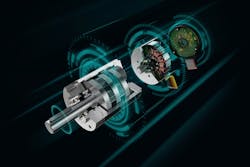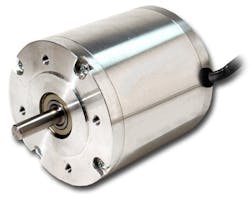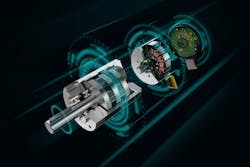Among the mechanical components that go into the design of the world’s two million different kinds of medical devices, consider the motor to be an unsung hero.
Embedded inside a medical device, the motor’s mechanical process is vital to the design and output specifications. It will need to undergo every bit of the same rigor and quality requirements as the device it powers.
Defining a medical device’s unique application requirements—chief among which is placing the most important stakeholder (the patient) at the heart of the design—ensures the selection of the ideal motor for a given application.
Quality Dynamics and Specifications
Today, medical device motors are required to be small, lightweight, efficient, reliable and precise. They should also be arcless (no sparks in normal operation), offer high power density and high speed, and emit minimal noise. Applications may vary from providing primary power in surgical tools, to position control in robotic joints. A collaborative approach between the motion solution and design engineering teams from the outset is vital.
Torque, radial and axial load are three characteristics present in typical applications. A Portescap whitepaper, which describes the impact of these characteristics on motor selection in detail, frames the discussion around sterilizable brushless DC slotted motors and miniature motor applications.
- Torque load determines whether a motor can perform a task, while radial and axial load specifications determine how long the motor can perform the task. The characteristic torque and velocity in an application over the entire motion cycle must be known in order to achieve the necessary mechanical power without overheating.
- Radial load is the maximum force that can be applied to the shaft in a direction that is perpendicular to the motor shaft axis. Axial load, also known as the thrust load, is the maximum force that can be applied to the shaft in parallel to the motor shaft axis.
- Load conditions and misalignment have an impact on the strength—or mechanical rigidity—of the shaft, bearings and motor case assembly. Life expectancy of the motor is dependent on how much these specifications are exceeded over time. Mechanical and design engineers consider all variables during the initial design stages to ensure smooth operations down the line.
BLDC Motors Gain Traction
Brushless DC motors or BLDC motors are suitable in medical technology applications because they last longer than competing technologies, argued this article from Machine Design’s archives. The author, Irvine Sloan, concisely explains the fundamentals of BLDC motors in medical applications.
A subset of commonly used DC motors, BLDC motors are synchronous (their rotor and stator magnetic fields rotate at the same frequency) and convert electricity to mechanical power. BLDC motors are equipped with a rotor that acts like a permanent magnet. They require no current, and rotation is achieved by changing the direction of the magnetic field produced by stationary coils. The control of BLDC motors can be done in sensor or sensorless mode, although sensorless control techniques are generally used when cost is a consideration.
READ MORE: Understanding Losses in BLDC Motors
BLDC motors are more reliable than brushed DC motors because they do not have any brushes to wear out and replace. Windings in BLDC motors are affixed to the housing, making it efficient at transferring heat away from the motor. BLDC motors tend to use less energy than other motor types and are widely used in applications due to their high efficiency and controllability.
Simple design, maintenance, minimal noise and clean operation are also cited as factors supporting the use of the BDLC motor in robotics, from steering systems in mobile robots to gripping arms and end-effectors.
There are downsides, too. According to Samuel Klein, an application engineer at Portescap, there’s no such thing as a perfect motor. He noted that there are there are always losses in the transformation when electrical power is converted to mechanical power.
The three main types of losses created during the conversion are friction losses, copper losses and iron losses. The best motor designs are those that save energy, and can be achieved by optimizing the ratio between copper and iron losses, Klein said.
Designing Custom and Off-the-Shelf Motor Solutions
Motor and motion control systems need to be custom engineered for each unique medical application. Understanding the speed and torque is merely a starting point for designing a custom motor or motion control solution. Other factors, such as the quality of motion, accuracy and repeatability, should also factor into the equation.
For some medical device manufacturers bringing new technology to market, the selection of the best motor for the application will depend on design engineers forging a harmonious relationship between the motion control technology and their own IP.
READ MORE: Reducing Time to Market Through Modular Motor Systems
These applications may involve extensive mechanical assemblies. Where implementing a fully housed motor is not required, precision and motion control systems designers can provide standard BLDC frameless motors that are custom-configurable.
For example, Moog’s Silencer series of inside rotor brushless DC motors were designed with MedTech in mind. The brushless design features bonded rare earth magnets and aluminum housings.
The motors range in diameters from 1.2 in. to 4.1 in. and lengths from 1.3 to 5.5 in. These motors offer continuous torque from 2.4 to 519 oz-in. and speeds up to 40,000 rpm. Options include electronic drives, encoders and gearheads, as well as Hall effect, resolver and sensorless feedback, noted Moog’s online catalog.
Similarly, German drive specialist Faulhaber extended its BXT flat motor series by adding matched gearheads, integrated encoders and speed controllers that are exceptionally short in the axial direction.
The motors, touted for their innovative winding technology and optimized design, are just 14, 16 and 21 mm in length and can deliver torques up to 134 mNm, within a diameter of 22, 32 and 42 mm respectively, noted a press release.
READ MORE: Improve Electric Motor Efficiency with Increased Phase Counts
For precise speed control or in the case of high requirements on positioning accuracy, diameter-compliant magnetic encoders or speed controllers were fully integrated into the housed motor variants, increasing the drive by just 6.2 mm.
These compact drive systems are suited for demanding applications and can be found in robotics, prosthetic joints, laboratory automation, pumps and medical technology, as well as aircraft cabin equipment.
About the Author

Rehana Begg
Editor-in-Chief, Machine Design
As Machine Design’s content lead, Rehana Begg is tasked with elevating the voice of the design and multi-disciplinary engineer in the face of digital transformation and engineering innovation. Begg has more than 24 years of editorial experience and has spent the past decade in the trenches of industrial manufacturing, focusing on new technologies, manufacturing innovation and business. Her B2B career has taken her from corporate boardrooms to plant floors and underground mining stopes, covering everything from automation & IIoT, robotics, mechanical design and additive manufacturing to plant operations, maintenance, reliability and continuous improvement. Begg holds an MBA, a Master of Journalism degree, and a BA (Hons.) in Political Science. She is committed to lifelong learning and feeds her passion for innovation in publishing, transparent science and clear communication by attending relevant conferences and seminars/workshops.
Follow Rehana Begg via the following social media handles:
X: @rehanabegg
LinkedIn: @rehanabegg and @MachineDesign


